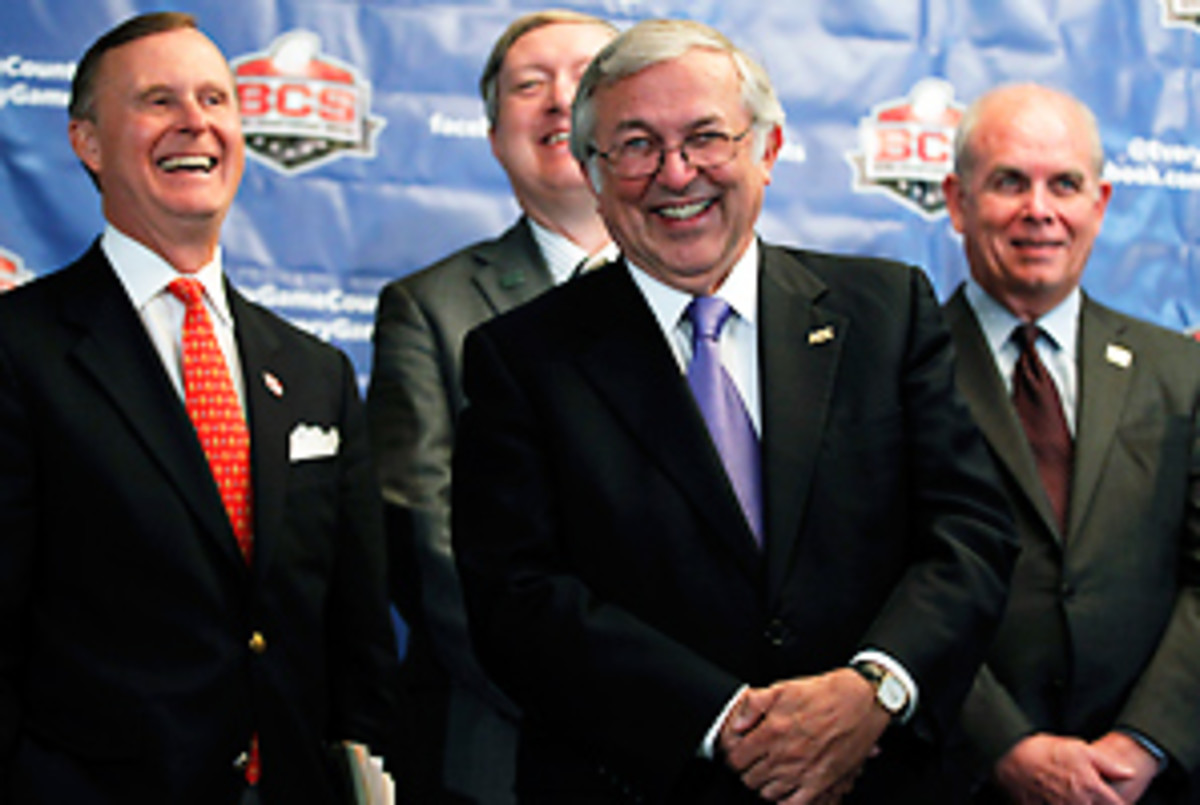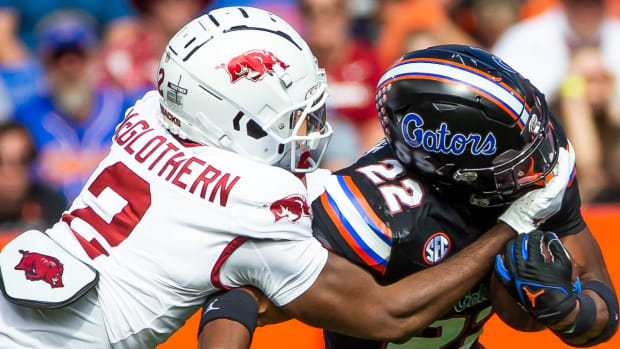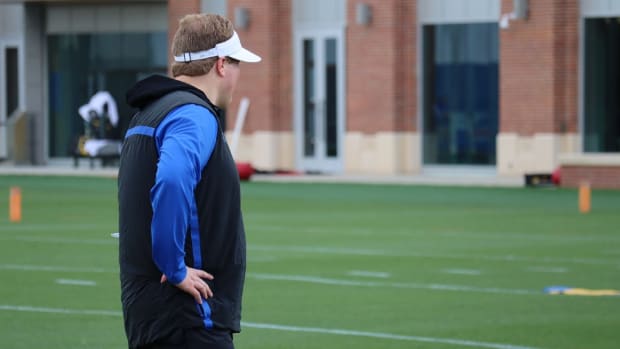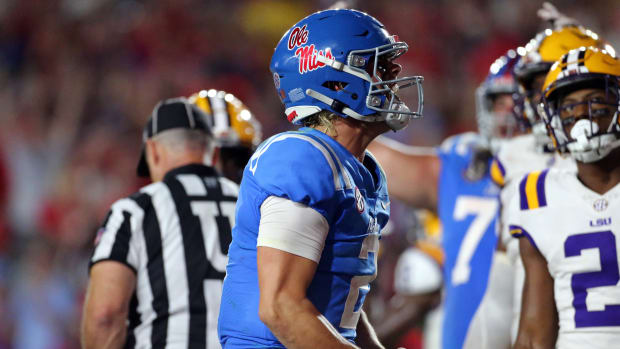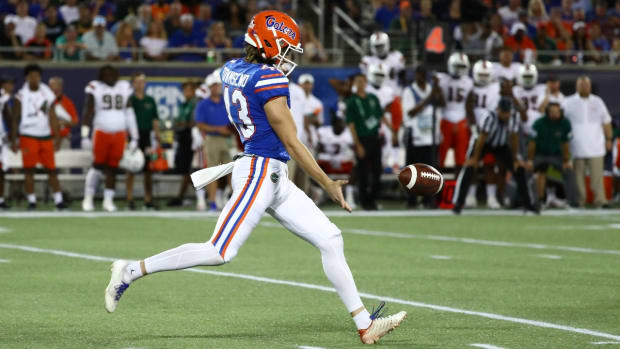After 65 years of waiting and debating, playoff finally here
Major college football is finally getting a playoff. Someone check the sky for pigs, the underworld for freezing temperatures.
After a little more than five months of discussion, the sport's current powerbrokers managed to approve a seemingly simple concept -- four teams playing three games to determine a national champion -- that they and their predecessors had previously spent more than a half-century debating, filibustering and squashing.
Legendary Michigan coach Fritz Crisler set the tone for decades of future angst. After both the Wolverines and Notre Dame finished the 1947 season undefeated, a New York Times headline decreed: "Crisler Discounts Value Of Play-Off." Citing "weather, physical requirements and other factors," the Michigan icon declared: "It will just have to be a winter hot stove argument every year."
That didn't stop future generations of coaches, administrators, commissioners, politicians, television executives and even an NBA owner from trying to devise a more conclusive resolution. But it did take 65 years for that resolution to become reality.
One of the earliest pioneers was Michigan State coach Duffy Daugherty. After sharing the 1965 national title with Alabama because the AP poll "waited until after we lost the Rose Bowl [14-12 to UCLA], played not in 1965 but 1966, to tell us we weren't national champions," the future Hall of Famer made a radical suggestion: scrap the popular New Year's Day bowls in favor of a potentially lucrative eight-team NCAA playoff.
"It would bring each school in the NCAA at least $20,000," Daugherty boldly predicted.
Longtime NCAA executive director Walter Byers supported Daugherty and commissioned a feasibility study. A nine-man committee, which included Alabama coach Bear Bryant, held its first meeting in 1968, but immediately ran into a sea of opposition from several conferences (the SEC, Big Ten and Pac-8) and bowl lobbyists. "We've had several hundred letters," said WAC commissioner and committee chair Paul Brechler, "and they've varied in tone."
Fortunately Brechler and his fellow committee members did not have e-mail or Twitter. Still, they disbanded within a year, passing the baton to similarly futile reformists for several decades.
In an opposing views op-ed on the front page of the Dec. 1, 1971 NCAA News, entitled "To Play Off or Not to Play Off ... That's the Question," Tennessee AD Bob Woodruff wrote the dissenting opinion. In doing so, he voiced many of the same anti-playoff talking points still being trotted out nearly 40 years later.
• Woodruff in 1971: "... there would be a very serious conflict in the academic area should our team be fortunate enough to qualify."
• Nebraska chancellor Harvey Perlman in 2009: "We have not seen a [playoff] proposal that doesn't implicate the academic success of student athletes."
• Woodruff in 1971: "With so many good football teams around, it would be very difficult for anyone to say who should qualify for the play-offs and who shouldn't."
• BCS executive director Bill Hancock in 2010: "A playoff is a lot easier on paper than it is in the real world. How many teams would play? How would the teams be selected?"
• Woodruff in 1971: "There seems to be no doubt that the playoffs would work a hardship on our old friends, the bowls."
• Oklahoma coach Bob Stoops in 2010: "If the playoffs come the bowls will go away. It's very naive to think they can coexist."
And so, college football's leaders managed to set a world record for the longest continuous barbershop debate.
"Joe Paterno Would Like Grid Playoff" -- Headline, Gettysburg Times, Dec. 9, 1968
On at least five occasions, beginning in the 1970s, the NCAA commissioned subcommittees to explore and devise potential playoff models. All either stalled or got the boot upon submission to the greater membership.
At the 1976 NCAA convention in St. Louis, the 134 Division I football schools (not yet divided into I-A and I-AA) took a vote on a proposed four-team measure. It needed a simple majority to pass. But as Sports Illustratedreported at the time, support was limited to "the McNeese States and Lamar Universities."
DeLoss Dodds, then and still the athletic director at Texas, authored a report in the spring of 1984 recommending a two- or four-team playoff. Delegates at a June Division I-A meeting shot it down with a show of hands.
And in 1994, a committee headed by UCLA chancellor Charles E. Young embarked on yet another feasibility study. The group eventually solicited feedback from several college players. As the story goes, Florida State linebacker Derrick Brooks suggested the players should receive a share of the event's expected financial windfall, and the committee tabled the project shortly thereafter.
The problem all along was that the major conferences had little use for the NCAA when they, along with the bowls, already had their own little postseason boondoggle. If there was ever going to be a playoff, it was surely going to take place on their own terms.
By the early '90s, they'd launched the Bowl Coalition, the first attempt to pit the top two teams in a bowl game whenever possible. It would soon be replaced by the Bowl Alliance. Finally, in 1996, longtime holdouts the Big Ten, Pac-10 and Rose Bowl finally signed on to form a "Super Alliance," soon to be rebranded the Bowl Championship Series. This would prove a seminal moment for the sport.
"It will clearly give the country a national championship game," Alabama AD Bob Bockrath said at the time. "It clears the whole situation up in terms of an undisputed national champion."
Clearly.
"I'm not here to say there will never be a college football playoff. But I don't believe it will be run by someone in Switzerland.'' -- SEC commissioner Roy Kramer, 1999
Even before Americans commenced their annual December tradition of bashing the BCS like a piñata, myriad groups and individuals put forth proposals for an alternative, including:
• A former Arizona State athletic director who in 1983 proposed placing a 24-team playoff on pay-per-view television to reap an estimated $1 billion.
• Nike and CAA, which in 1993 pitched a $100 million playoff of eight bowl winners to the NCAA Presidents Commission.
• A now-defunct Swiss marketing firm that in 1998 offered the conferences $2.4 billion over eight years to stage a 16-team playoff.
• The Mountain West Conference, which threatened not to sign off on the current BCS contract in 2009, instead proposing an eight-team bracket. (When that failed, the MWC tried for 16 last year.)
• Georgia president Michael Adams who, the morning after the polls decreed his Bulldogs the No. 2 team of 2007, conveniently unveiled his own eight-team playoff proposal.
• Dallas Mavericks owner Mark Cuban, who in December 2010 pledged to basically throw so much money at schools they wouldn't be able to resist.
• And of course, President-elect Barack Obama, who in a November 2008 interview with 60 Minutes pledged to "throw my weight around a little bit" in hopes of an eight-team playoff.
None of them succeeded, and as recently as Jan. 10, 2011, Hancock told reporters covering that night's Oregon-Auburn BCS championship game: "There is no overwhelming support to do anything different." Exactly one year later, the morning after last season's Alabama-LSU snoozer, the commissioners met at a New Orleans hotel to begin discussing the future, after which Big Ten commissioner Jim Delany told several of those same reporters: "Everything is in the mix."
Lo and behold, five months later, we have a playoff.
None of the powerbrokers has yet to offer a succinct explanation for the sudden about face. "[The commissioners] are listening to the fans," Hancock said in April. But if that were the case, why did no one listen when, during the 1980 Bluebonnet Bowl broadcast, 91 percent of respondents to an on-air call-in survey said they preferred a playoff?
"What people don't understand is, it's been an evolutionary process," said recent acting Big 12 commissioner Chuck Neinas, 80, who may understand better than anyone the glacial pace of evolution. As executive director of the now-defunct College Football Association, Neinas first pitched a playoff model within the bowl system to his members in ... 1989.
"We didn't have a lot of support at that time," Neinas said.
Neinas has worked in college athletics administration since 1961, long enough to witness every ill-fated exploratory committee and feasibility study of the past 50 years. Tabbed as an emergency replacement for the ousted Dan Beebe last September, Neinas only ran the Big 12 for nine months. Yet it was during that time Neinas, Mike Slive, Delany, Larry Scott and Co. managed to hunker down in enough hotel conference rooms across America to finally reach the playoff compromise that they and so many before them had rejected.
"I'll say it again -- over my dead body. Mark that down -- we will not have a playoff in this era -- period." -- Ohio State President Gordon Gee, 2009
The playoff is here. Someone better check Dr. Gee's pulse.
